|
The Energy-Water Nexus webpage of Sandia National Laboratories states: “These two critical resources are inextricably and reciprocally linked; the production of energy requires large volumes of water while the treatment and distribution of water is equally dependent upon readily available, low-cost energy. The nation’s ability to continue providing both clean, affordable energy and water is being seriously challenged by a number of emerging issues.”
Adequate affordable supplies of both clean water and energy are vital to our nation’s well being and prosperity. However, this co-dependancy can lead to conflict. In recent years, one of the most highly-visible areas of friction in the Energy-Water Nexus has been the use of fresh water in hydraulic fracturing activities. One can hardly open a newspaper without encountering a story about hydraulic fracturing and the affects of the growing use of the technology on clean water.
One of the locations where this conflict is ongoing is in south Texas where hydraulic fracturing activities are being conducted at an increasing pace to extract oil and gas from the Eagle Ford Shale.
Fracking and the Use of Fresh Water
Hydraulic fracturing, the practice of injecting water and a mixture of proppants and chemicals at very high pressure into a low-permeability, hydrocarbon-rich formation, has been used for decades to produce oil and gas. More recent developments in horizontal drilling technologies, combined with hydraulic fracturing, has led to a significant increase in the production of oil and gas from shale formations such as the Bakken in North Dakota, the Eagle Ford and Barnett in Texas, and the Marcellus in Pennsylvania and neighboring states.
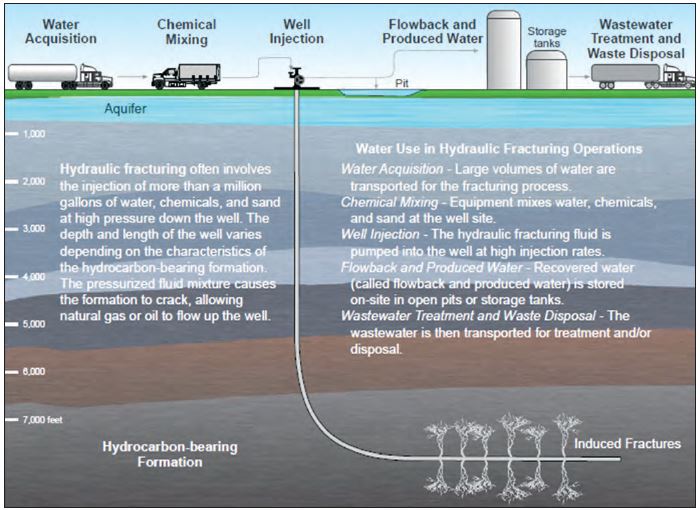
Hydraulic fracturing operations involve the use of a large volume of fresh water. In general, one to six million gallons of water are used in the fracturing operations. at each well. The volume varies depending on the length of the target zone and the geomechanical properties of the producing formation. The majority of water used in fracturing operations is drawn from surface water sources. Secondarily, municipal water supplies and groundwater sources are used. Typically, the water is transported to the well site by tanker truck. A single fracturing job can require more than 300 tanker truck loads of fresh water.
Operators prefer to use fresh water for hydraulic fracturing because it is less corrosive than water with higher concentrations of dissolved solids. Lower quality water with higher concentrations of dissolved solids must be treated prior to use in fracturing operations. The additional costs associated with the treatment of low quality water makes the use of fresh water more attractive.
In many areas where hydraulic fracturing is conducted there are adequate supplies of fresh water available. In these areas, the use of the fresh water does not stress the existing available supplies are relied upon by other users. However, in drier regions where rainfall is rarer and surface water sources are allocated, the use of fresh water for fracturing can put stress on the local availability of water. Some of the drier areas where hydraulic fracturing is conducted are in Texas, specifically, in west Texas and south Texas.
South Texas and the Eagle Ford Shale
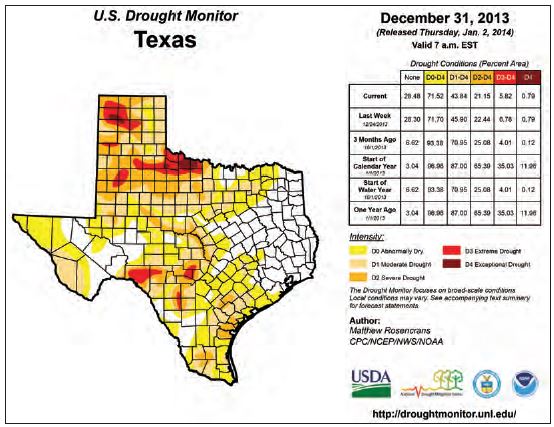 Average rainfall in parts of south Texas amounts to less than 20 inches per year. During many of the recent years, precipitation totals have fallen short of the annual average and the region is suffering through a persistent long-term drought. According to the United States Drought Monitor for the end of December 2013, more than 71 percent of Texas is in drought and large parts of south Texas are still in moderate or severe drought conditions despite recent rainfall. Under the rolling hills, scrub brush, and dusty ranch lands of south Texas lies the Eagle Ford Shale. Average rainfall in parts of south Texas amounts to less than 20 inches per year. During many of the recent years, precipitation totals have fallen short of the annual average and the region is suffering through a persistent long-term drought. According to the United States Drought Monitor for the end of December 2013, more than 71 percent of Texas is in drought and large parts of south Texas are still in moderate or severe drought conditions despite recent rainfall. Under the rolling hills, scrub brush, and dusty ranch lands of south Texas lies the Eagle Ford Shale.
According to the Railroad Commission of Texas, the Eagle Ford Shale is a hydrocarbon producing formation of significant importance due to its capability of producing both gas and more oil than other traditional shale plays. The Eagle Ford contains a higher carbonate/shale percentage than similar shale formations, upwards to 70% in south Texas, which makes the formation more brittle and “fracable.” The Eagle Ford Shale play trends across 26 Texas counties from the Mexican border northeastward into East Texas, roughly 50 miles wide and 400 miles long with an average thickness of 250 feet. The formation is Cretaceous in age resting between the Austin Chalk and the Buda Lime at a depth of approximately 4,000 to 12,000 feet.
Petrohawk drilled the first well to produce oil and gas from the Eagle Ford Shale in 2008 in LaSalle County, Texas. In the first six months of 2013, the Eagle Ford produced 2.69 billion cubic feet of natural gas and 599,000 barrels of oil and condensate per day. This rate of oil production represents an increase of 51 percent over the average 2012 production rate. By the end of 2013, oil production from the Eagle Ford had increased to more than one million barrels per day. In 2011, the United States Energy Information Administration reported that the Eagle Ford had proven reserves of 1.25 billion barrels of oil and 8.4 trillion cubic feet of gas. More recent estimates of the oil reserves are in excess of three billion barrels.
Since Petrohawk’s initial well in 2008, drilling activity and associated hydraulic fracturing operations have been increasing rapidly in the Eagle Ford. These activities have required the use of fresh water in increasing quantities. But, the Eagle Ford underlies some of the most water stressed parts of the state. Following the severe drought in Texas in 2011, concerns have grown that use of fresh water for hydraulic fracturing in the area has been competing for this scarce resource with municipal, agricultural, and industrial users.
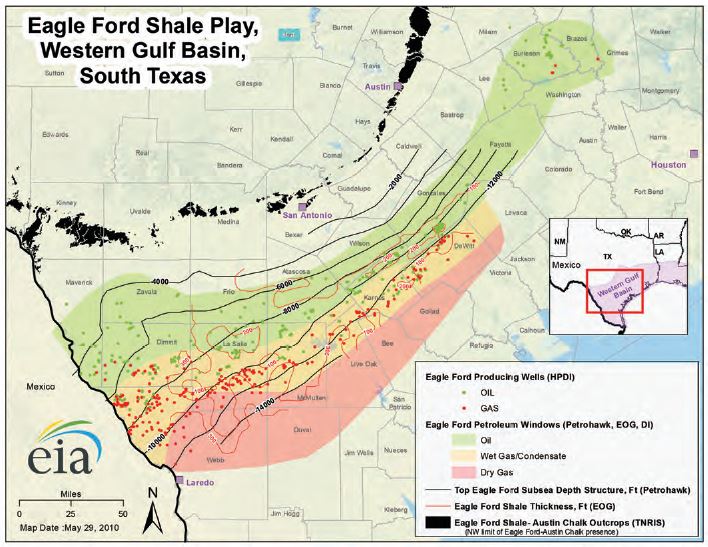
The Search for Fresh Water and Conflicts
Hydraulic fracturing of an average Eagle Ford well requires four to six million gallons of water, or roughly 15 acre-feet, over a period of several days, according to an industry source. An acre-foot, a measurement used in agriculture and municipal calculations, is the volume of water that will cover an acre of land to a depth of one foot. An acre-foot is approximately 326,000 gallons. Drillers working the Eagle Ford Shale in south Texas cumulatively use approximately 15,000 acre-feet (nearly 4.9 billion gallons) of water annually by some estimates.
A widely cited study from the University of Texas at Austin, funded by the oil and gas industry, had predicted that hydraulic fracturing in the Eagle Ford would use a maximum of around 35,000 acre-feet of water annually. The lead author, Jean-Philippe Nicot, a research scientist at Bureau of Economic Geology, said he now thinks the actual use in the Eagle Ford is around 40,000 acre-feet annually.
Operators point out that fracturing activities consume only about one percent of all fresh water used in Texas, much less than municipal and irrigation users. While the volume of water used is small compared to state-wide water use, the local affects can be magnified. The Southwest Research Institute, a non-profit, San Antonio-based research and development organization, estimated that the cumulative water use for hydraulic fracturing can be equal to approximately half the regional annual recharge in normal years to the Carrizo-Wilcox Aquifer, a major groundwater source for parts of the state.
This increasing consumption of fresh water for fracturing operations has caused concerns for some local water users in south Texas. Hugh Fitzsimmons, the owner of a large ranching property in Dimmit County 100 miles southwest of San Antonio and a board member of the Wintergarden Groundwater Conservation District is worried about use of the groundwater that often serves as the primary supply in the sparsely populated county. In 2009, there were just 107 oil and gas wells in Dimmit County. By 2012, there were 2,137. “It is not the process that I object to,” said Mr. Fitzsimmons in a September 2013 article in Time Magazine by Hilary Hylton, “but it’s all the ancillary issues that come with it. Air quality declines as some wells flare off gases, and heavyweight rigs and water-hauling trucks destroy back-country roads. But most of all, locals want the frackers to use less water.”
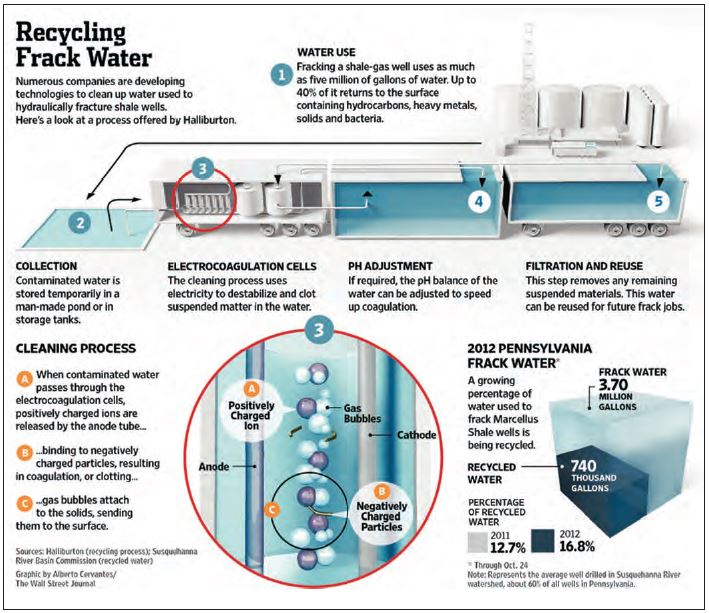
In a May 2013 column titled “Don’t mess with Texas water, frackers warned,” John Kemp a Reuters market analyst states that, “the real problem is not water supplies but their management.” He notes that the amounts of water employed in hydraulic fracturing are small relative to other uses, even in dry areas, and do not pose a serious threat to the availability of water. The potential for problems arises instead from the unusual system of water rights still employed in Texas and its relatively weak controls on groundwater use in some parts of the state.
Groundwater use in Texas is not regulated at the state level. Rather, state law allows the establishment of groundwater conservation districts which regulate groundwater use at the local or county level. In some counties, the groundwater conservation districts limit the pumping of groundwater. Some of these districts have exempted oil and gas operations from pumping limitations. Hydraulic fracturing has been granted exemptions from water-use restrictions along with traditional oil and gas drilling. But now some conservation districts are distinguishing fracturing operations from drilling and regulating the water use as a separate activity because fracturing uses up to 30 times as much water than simply drilling a well.
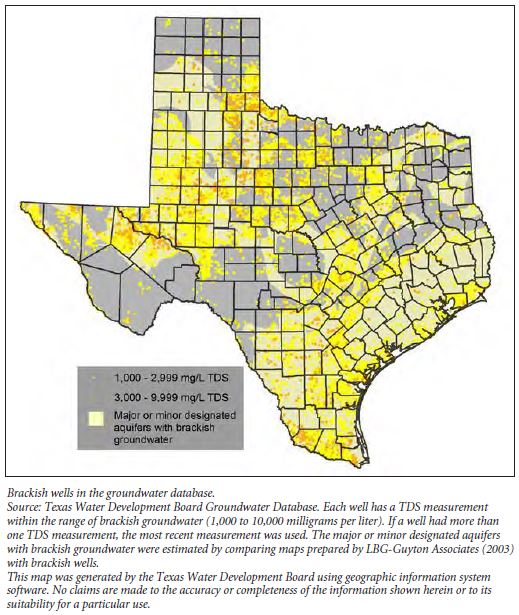 The Evergreen Underground Water Conservation District, encompassing all of Atascosa, Frio, Wilson, and Karnes counties, includes 2,461,000 acres or 3,845 square miles. The District’s economy is heavily dependent upon agriculture and agriculture related business. Approximately 80 percent of the total groundwater pumpage in the District is used in agriculture. The District, which overlies areas of Eagle Ford Shale production has implemented groundwater use restrictions for fracturing activities since 2008. The restriction limits the pumpage of fresh groundwater and brackish groundwater based on the acreage that the owner holds. The Evergreen Underground Water Conservation District, encompassing all of Atascosa, Frio, Wilson, and Karnes counties, includes 2,461,000 acres or 3,845 square miles. The District’s economy is heavily dependent upon agriculture and agriculture related business. Approximately 80 percent of the total groundwater pumpage in the District is used in agriculture. The District, which overlies areas of Eagle Ford Shale production has implemented groundwater use restrictions for fracturing activities since 2008. The restriction limits the pumpage of fresh groundwater and brackish groundwater based on the acreage that the owner holds.
The scarcity and search for water sources in south Texas has led to a new revenue stream for some ranchers. According to a comment paper by Taelor A. Allen published in the St. Mary’s Law Journal in January 2013 titled “The South Texas Drought and the Future of Groundwater Use for Hydraulic Fracturing in the Eagle Ford Shale,” it has become common practice for many landowners to capitalize on the ability to sell water for hydraulic fracturing in a lucrative business known as ‘water wildcatting.’ Some landowners are receiving anywhere from ten to eighty cents per barrel of water.”
Another Water Source
A potential solution to conflict over the use of fresh water may be the use of another water source. This other water source might be the 2.7 billion acre-feet of brackish groundwater that lies beneath Texas. Brackish groundwater is currently going largely unused in Texas so its potential use would not conflict with any current users. Salts and chemicals in the brackish groundwater that are incompatible with the fracturing method can be removed by a variety of treatment methods including reverse osmosis. Halliburton, a major contractor in the hydraulic fracturing business, has a goal to reduce fresh water use by 25 percent in the United States by the end of 2014, according to industry reports. Reducing freshwater use “is no longer just an environmental issue — it has to be an issue of strategic importance,” Salvador Ayala, vice president of well production services told an industry group recently, according to the Wall Street Journal.
A Water Substitute?
Some operators are looking for ways to reduce the volume of fresh water used in hydraulic fracturing operations and are investigating the use of alternative fluids. In a June 2013 column on the financial website Motley Fool, David Smith writes that operators in Tennessee are experimenting with the use of nitrogen gas for shallow fracturing operations in the gas-bearing Chattanooga Shale. The nitrogen is used with water and additives to create a foam. The foam, which is 53 to 95 percent nitrogen, has the viscosity and related properties sought by the operator. The percentage of water used in the foam is often increased for deeper fracturing targets.
David Smith reports that, according to Air Products and Chemicals, a supplier of nitrogen, the use of the gas is about 15 percent more expensive than the use of fresh water. He notes however that the difference in cost is largely offset by an 11 percent increase in the estimated ultimate recovery of natural gas. An additional benefit of the nitrogen use is the elimination of costs associated with the collection, transport, and treatment of flowback water.
The potential use of nitrogen in fracturing operations is limited by several factors. Nitrogen use is most applicable in shallow operations, typically less than 5,000 feet deep. Also nitrogen is a poor carrier of proppant, so the target formation should be brittle with natural fractures that can stay open with proppant after the pressure is reduced.
The benefits of low-water volume fracturing in times of increasing water scarcity are hardly inconsequential. For instance, whereas in recent years farmers in some parts of Colorado paid from $9 to $100 for an acre foot of water to cities with excess supplies, energy companies are now paying $1,200 to $2,900 per acre foot.
Recycling Returns
About two-thirds of the water used in a hydraulic fracturing operation remains underground after drilling. The remaining third comes back to the surface as flowback. The flowback, which contains the fracturing additives plus residual materials from the formation and dissolved hydrocarbons, is a wastewater that is typically transported offsite for treatment and disposal. Proper management of the this waste stream involves significant costs. Often this wastewater is disposed underground through an injection well. Some states, including Colorado, require recycling of all flowback water recovered at the well site. Texas has added incentives to encourage drillers to recycle, but so far has not made this a requirement.
The oil and gas industry is moving towards greater development of recycling strategies and other injection options for the flowback water, according to David Burnett, director of technology at Texas A&M’s Global Petroleum Research Institute. Truck-mounted treatment and recycling units are now operating throughout south Texas. Researchers at the University of Texas at San Antonio are investigating charcoal as a potential water treatment option for the wastewater stream.
Summary
The interdependency and intricacies of the Energy-Water Nexus can lead to imbalances in the use and the availability of critical resources. The increasing application of hydraulic fracturing has led to great increases in the production of oil and gas from shale formations in many parts of the nation. This increase in the production of energy has led to greater prosperity for many, but has come at the cost of water availability for others. But the Energy-Water Nexus does not have to be a situation where one party wins and one party loses. As seen with the implementation of new strategies to reduce the use of fresh water resources in hydraulic fracturing operations, innovation and co-operative efforts can lead toward solutions that accommodate the needs and interests of all stakeholders.
|



 Average rainfall in parts of south Texas amounts to less than 20 inches per year. During many of the recent years, precipitation totals have fallen short of the annual average and the region is suffering through a persistent long-term drought. According to the United States Drought Monitor for the end of December 2013, more than 71 percent of Texas is in drought and large parts of south Texas are still in moderate or severe drought conditions despite recent rainfall. Under the rolling hills, scrub brush, and dusty ranch lands of south Texas lies the Eagle Ford Shale.
Average rainfall in parts of south Texas amounts to less than 20 inches per year. During many of the recent years, precipitation totals have fallen short of the annual average and the region is suffering through a persistent long-term drought. According to the United States Drought Monitor for the end of December 2013, more than 71 percent of Texas is in drought and large parts of south Texas are still in moderate or severe drought conditions despite recent rainfall. Under the rolling hills, scrub brush, and dusty ranch lands of south Texas lies the Eagle Ford Shale.

 The Evergreen Underground Water Conservation District, encompassing all of Atascosa, Frio, Wilson, and Karnes counties, includes 2,461,000 acres or 3,845 square miles. The District’s economy is heavily dependent upon agriculture and agriculture related business. Approximately 80 percent of the total groundwater pumpage in the District is used in agriculture. The District, which overlies areas of Eagle Ford Shale production has implemented groundwater use restrictions for fracturing activities since 2008. The restriction limits the pumpage of fresh groundwater and brackish groundwater based on the acreage that the owner holds.
The Evergreen Underground Water Conservation District, encompassing all of Atascosa, Frio, Wilson, and Karnes counties, includes 2,461,000 acres or 3,845 square miles. The District’s economy is heavily dependent upon agriculture and agriculture related business. Approximately 80 percent of the total groundwater pumpage in the District is used in agriculture. The District, which overlies areas of Eagle Ford Shale production has implemented groundwater use restrictions for fracturing activities since 2008. The restriction limits the pumpage of fresh groundwater and brackish groundwater based on the acreage that the owner holds.